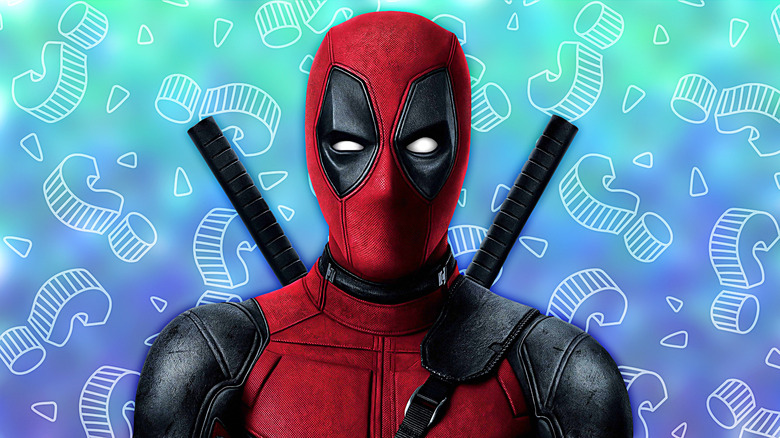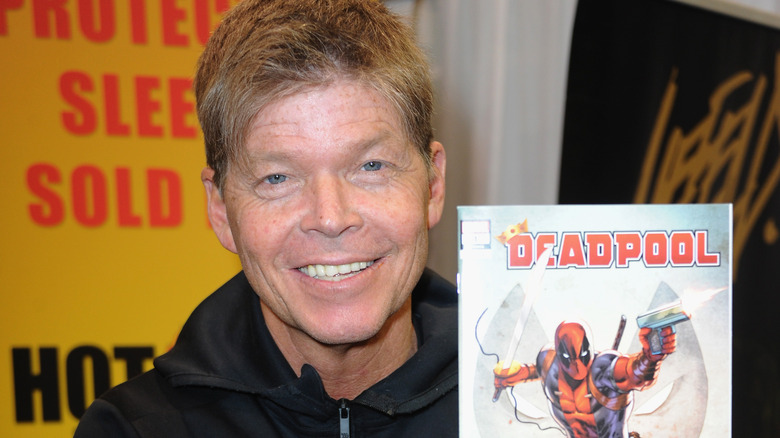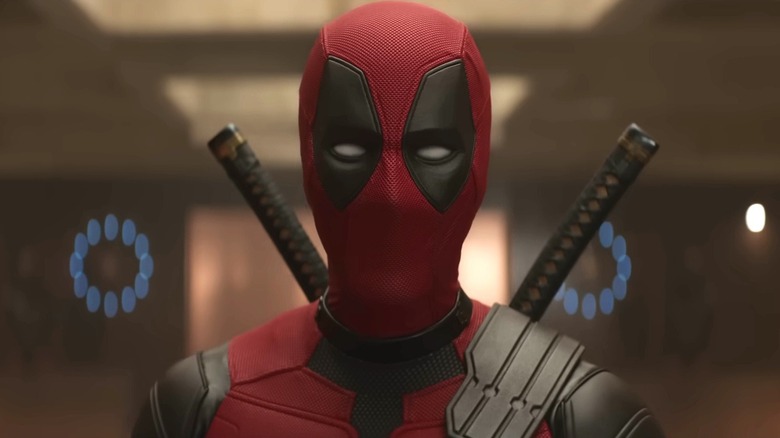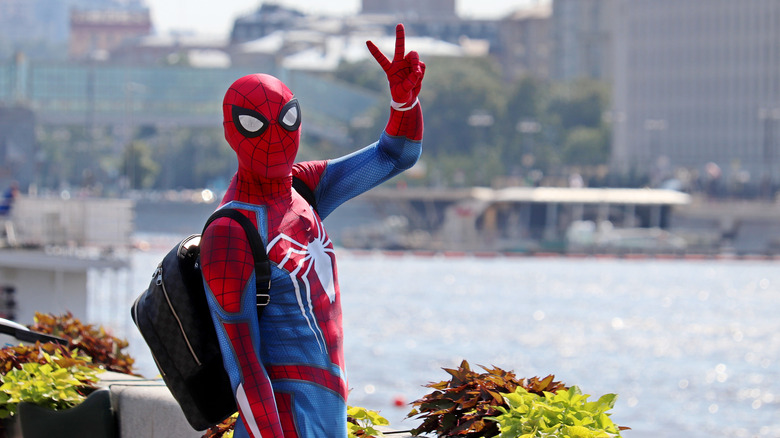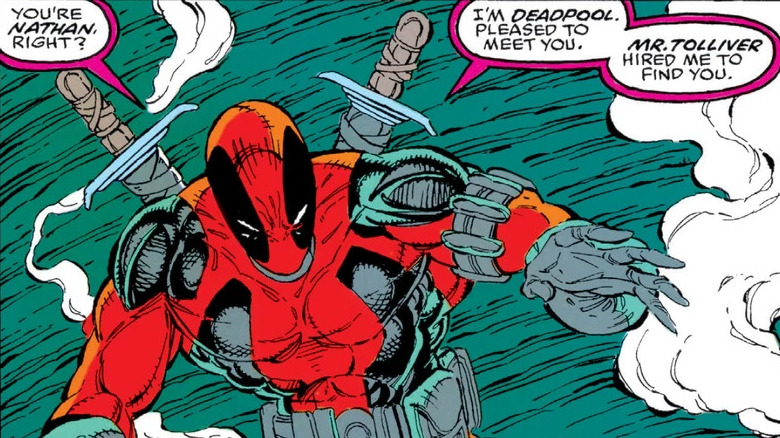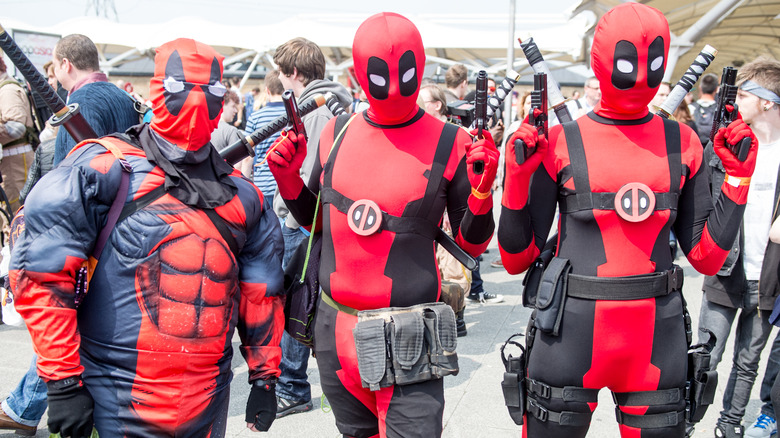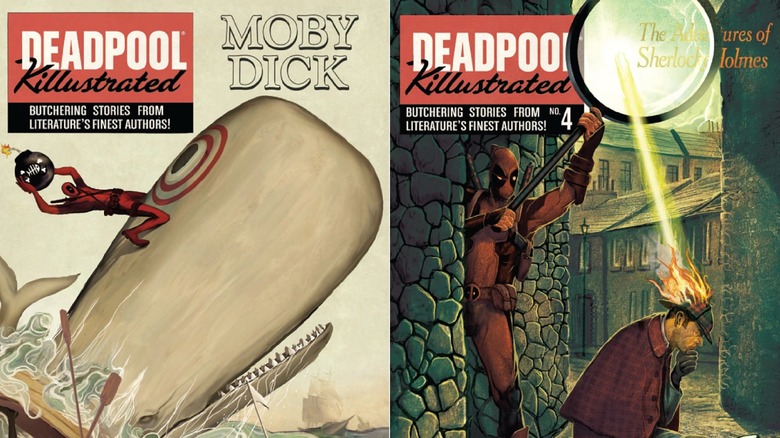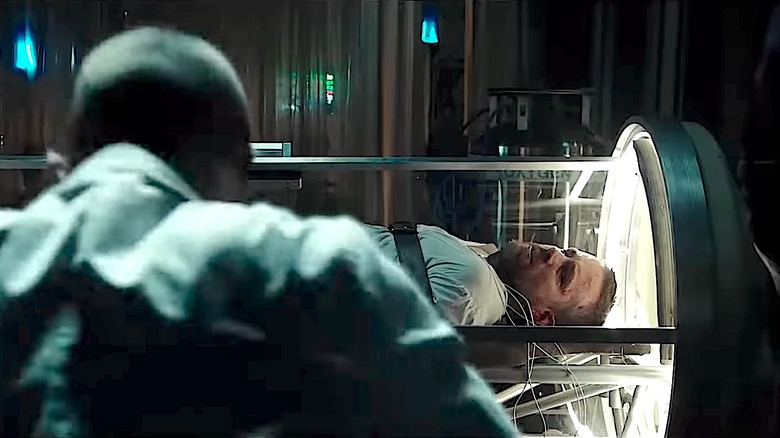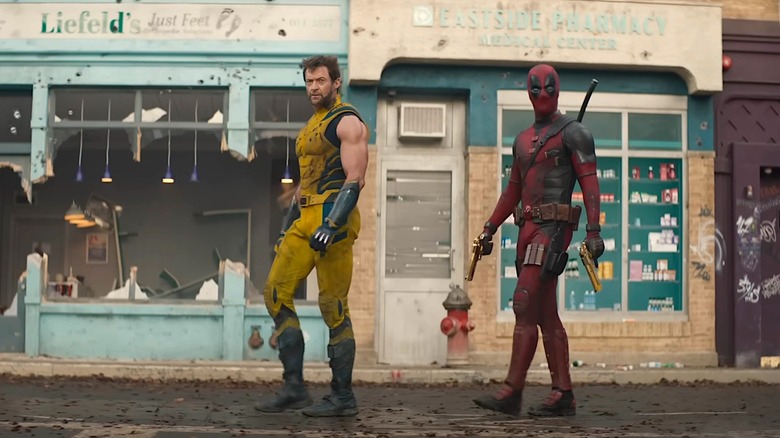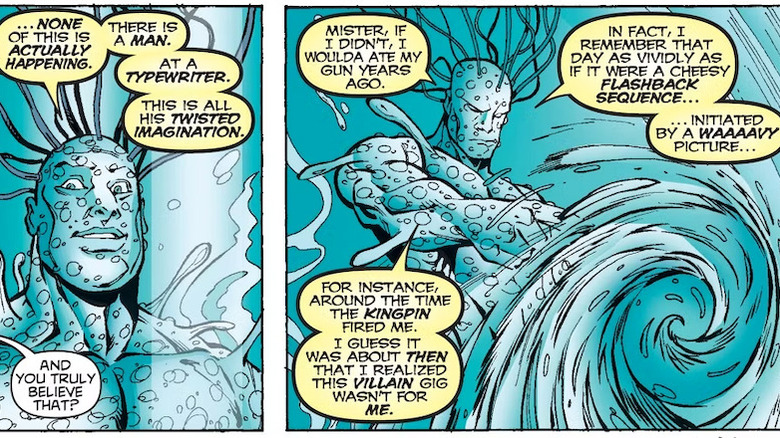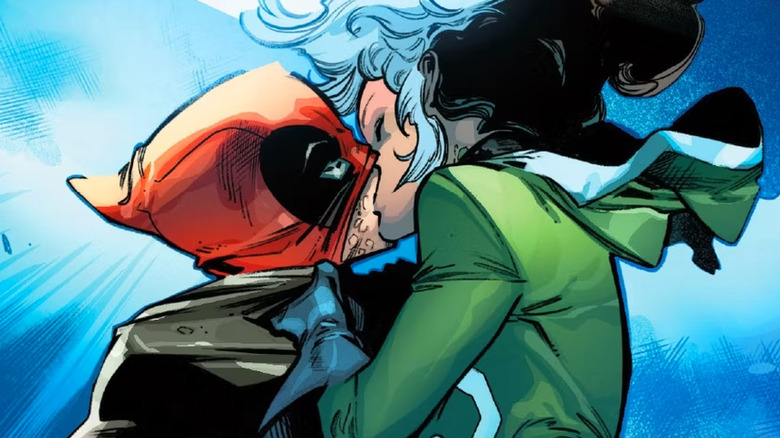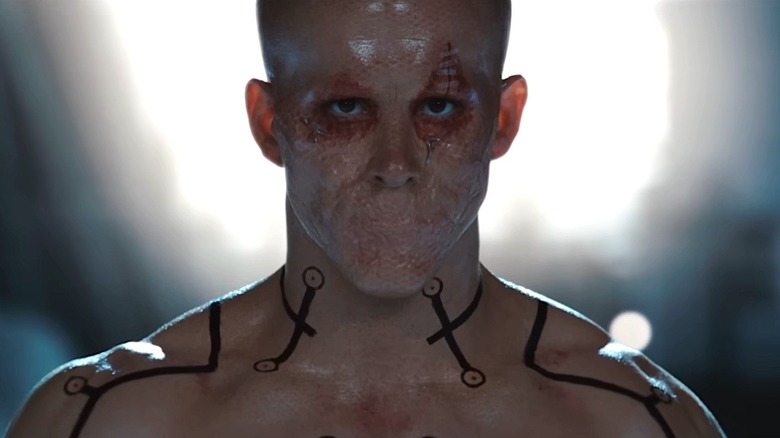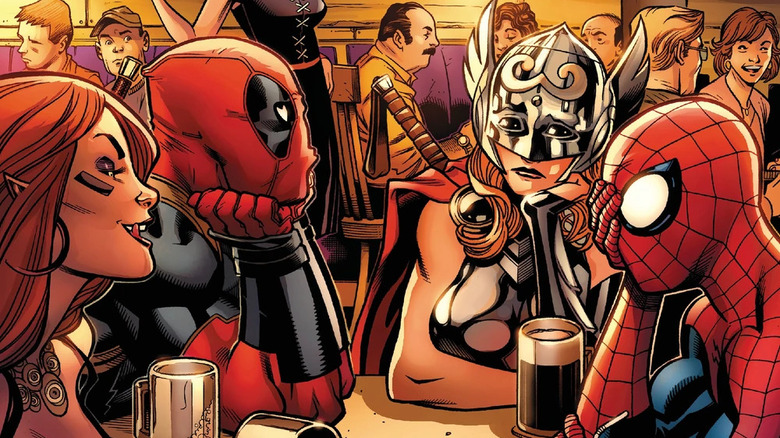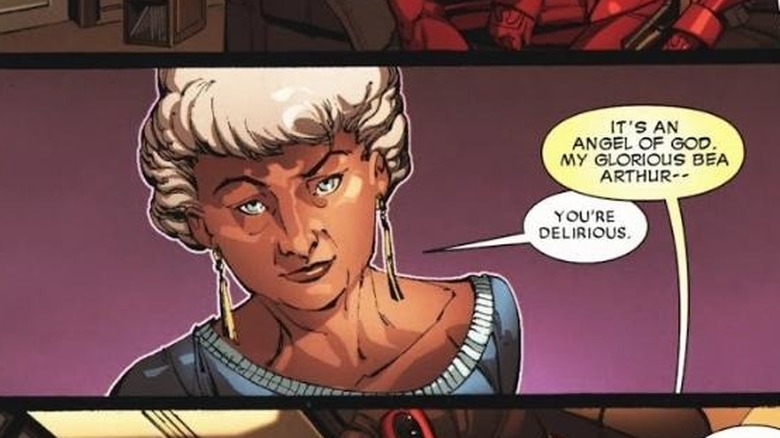The Most Difficult Deadpool Questions Finally Answered
A disfigured and disillusioned would-be hero finds the only way to survive his own superpowers and disappointment is to live in service of others — yeah, that's 20% Deadpool. Replace "in service of others" with "as a killer for hire," add 50% referential sarcasm, 28% violent bloodshed, and 2% Bea Arthur jokes, and you've pretty much assembled the "Merc with a Mouth."
Deadpool is the red-super-suited star of comics that got their full start in 1993 after an '83 introduction, and the character allowed actor Ryan Reynolds the perfect outlet for his blend of poppy, angry, hard-R humor with a film series that kicked off with 2016's "Deadpool" and is still going strong. Deadpool has been spilling blood and printing money for years and is one of Marvel's most wildly popular characters. The trailer for "Deadpool & Wolverine" is the most-watched movie trailer in history, for Peter Parker's sake.
But how did a merciless mercenary with a penchant for pop culture references and his own Marvel tie-in katana sword merch get so big? Why is his dark, twisted heart so seemingly small? And seriously, what's the deal with his crush on Bea Arthur? Deadpool is an almost-undead guy who's lived many lives and has the scars to show for it — so let's try and keep track of some of them. Buckle up, peanut. Let's slice through the madness to get to the most difficult Deadpool questions, finally answered.
Who created Deadpool?
Deadpool got his start in comics artist and writer Rob Liefeld's twisted brain, paired up with writer Fabian Nicieza's possibly even more twisted pen. "If a janitor scripted New Mutants #98, he'd be the co-creator — that's how it works, buddy," Liefeld said in a New York Times profile, adding, "Deadpool does not exist in any way, shape or form without me. ... I wrote the stories. Like Jim Lee and others, I worked with a scripter who helped facilitate. I chose Fabian, and he got the benefit of the Rob Liefeld lottery ticket. Those are good coattails to ride."
Yikes. With co-creators like that, who needs co-creators? To Nicieza's credit, he seems to take Liefeld's ego in stride. Per his X posts, the pair are on good terms, and Nicieza lists himself as a co-creator in his bio for the site. Since Deadpool's creation, many writers and artists have interpreted him, including but not limited to Gail Simone (whose work inspired the "Birds of Prey" movie), Brian Posehn, Christopher Priest, and a defining architect of Deadpool's good (maniacal) humor in the comics that is also reflected in the movies, Joe Kelly. Simone, Posehn, Priest, and Kelly — along with Liefeld and Nicieza — have given Deadpool some of his best moments in comics history (like that time he and Wolverine destroyed North Korea).
How did Deadpool get his name?
"Deadpool." What a name. It sounds, well, like a murderous supervillain name from a '90s comic. But shockingly, the super-antihero moniker of Wade Wilson wasn't just picked at random from The Giant Book of Scary Killer Baby Names. Instead, the name "Deadpool" has its origins in co-creator Robert Liefeld's childhood.
"I had a notebook full of names," Liefeld told Vulture, saying that he would jot down character names whenever inspiration struck. Inspiration struck red-and-black gold when his parents mentioned the celebrity "dead pool" they ran with each other: When one celebrity died, Liefeld's parents took bets on who the next celebrity would be to die. Quaint! Liefeld said he liked the sound of the phrase so much, he smashed the words "dead" and "pool" together to create comics history.
In the movies, of course, Deadpool gets his name from the chalk board "dead pool" run by Weasel (T.J. Miller), barkeep at Sister Margaret's. His name's origin in the comics is similar but more grisly — as a patient in Weapon X experiments, Wade and his fellow patients are subject to the doctors' own "dead pool," where they take bets on which patient is going to snuff it next.
What inspired Deadpool?
In the early '90s, Rob Liefeld was a rising comics star. When penciling for Marvel, Liefeld's higher-ups asked if he could breathe some new life into "The Mutants," a struggling "X-Men" sidestory comic. Liefeld was a young hotshot — a student of comics, devotee of Wolverine, and lover of Spider-Man. He came up with a pack of villains, including Deadpool.
"I specifically told Marvel, 'He's Spider-Man, except with guns and swords,'" Liefeld told Vulture. He told Complex, "I wanted a mercenary, a bounty hunter who got in the Weapon X program, got screwed up and pissed off and sold his talents to the highest bidder. He was a jackhole." That jackhole also operated in an aura of grief. Fans of Liefeld's might be surprised to know his father suffered a 20-year bout with brain cancer.
"My entire 10th grade year, my dad was in a coma," Liefeld told Forbes. "That changes a person. It changes a kid. It makes you ridiculously independent. And I had a fire in me, I was going to succeed, 'New Mutants' was going to be my vehicle that I could push all of my stuff in." Some of that stuff seems to directly channel the rage surrounding cancer and even Wade's desperation to treat his own illness with the Weapon X program.
How did Deadpool start out?
Deadpool didn't actually begin his comics life as a lovably foul-mouthed antihero. Instead, Deadpool began as a true supervillain — even if that role was relatively short-lived. Deadpool's first comics appearance, in "New Mutants" #98, featured him working against a character named Cable, a tough, time-traveling hero. "I was a student of the 'X-Men', so I knew everybody needed a soap opera," Rob Liefeld explained to Forbes. In Deadpool's premier issue, Cable spends the story assembling and training a team of heroes. Finally, Deadpool enters the story and mercs all of them, right in front of Cable, without breaking a sweat.
"But on the last page, who comes in and kicks Deadpool's ass? Domino! And then one year later, you find out that she was a plant," Liefeld gleefully told Forbes, adding that the soap opera qualities of Deadpool and Cable's badassery made the issue a staggering 650,000 sales — and set the tone for the future of all things "Deadpool."
Why did Deadpool get and stay so popular?
The popularity of the "Deadpool" movies can partially be attributed to their star, who might be the most beloved Canadian Ryan after Ryan Gosling. Charming, funny, and handsome with or without melted-face prosthetics, Ryan Reynolds is a beacon of charisma — even Reynolds' worst-rated movie is still worth watching. But the fact that there are even "Deadpool" movies at all, in production decades after the comic's debut, begs the simple question: What is wrong with us all that we can't stop loving this character? And why did we start in the first place?
A main reason is Deadpool's killer sense of humor. This is the kind of guy who would laugh at a funeral, likely one that he caused. Deadpool debuted during the '90s comics boom, and his dark, irreverent, even immature humor, full of pop culture references and meta comments on the superhero comics genre, was a far cry from the super-serious superhero comics of the day. Cough, "The Death of Superman," cough.
Also contributing to his popularity was Deadpool's accessibility to new readers. With less lore to deal with than other heroes and more or less standalone stories, Deadpool is an attractive sell, in both the comics industry's late-'90s lean years and the grim state of comics today. Deadpool's humor, violence, and acidity are truly timeless treasures — and lucrative ones.
What are the weirdest Deadpool titles?
Deadpool is a mercenary. He sells his superpowered slaying skills to the highest bidder, and sometimes even goes extra-insane in the process. While his "average" comic runs would send Spidey running home to Aunt May and Uncle Ben, his series called "Deadpool Killustrated", which features four volumes of Deadpool killing his way through classic literature like "Moby Dick," "A Christmas Carol," and "The Adventures of Sherlock Holmes," have got to be the positively most perverse 'Pool titles on offer.
If you think the above sounds fairly straightforward, don't worry, it isn't. Dracula, Frankenstein's monster's creator, Beowulf, and all of the "Little Women" show up at some point in "Deadpool: Killustrated." Deadpool tries to kill them all, because this run takes place in a multiverse gone madder than anything "Doctor Strange" could dream up.
These books feature writer Cullen Bunn's take on Deadpool, from the "Deadpool Killogy." Bunn's Deadpool has already slayed most of the superheroes in the Marvel Universe, so in "Killustrated," he turns his killer instinct on literary characters before finally taking aim at himself in "Deadpool Kills Deadpool," also from Bunn.
Where did Deadpool get his powers, and how do they work?
Before Deadpool was Deadpool, he was Wade Wilson – a good-looking, skilled military combatant struck down with cancer. Desperate for a cure, Wade agrees to take part in the Weapon X program for treatment. He gets it, and then some. Weapon X is actually a secret government program that creates superpowered mutants for militaristic purposes. To paraphrase the villainous Ajax in the 2016 "Deadpool" movie, Weapon X creates super slaves out of super soldiers. Oops!
Being turned into a super-powerful force to be reckoned with means Deadpool has regenerative healing powers, keen reflexes, excellent marksmanship, even more excellent sass-manship, ninja-like fighting prowess, the ability to speak multiple languages, and near-immortality. Sound like any other haunted, gruff superheroes you know? Who might rhyme with stool-verine?
"Weapon X, that's a Roman No. 10," Rob Liefeld told Vulture about Deadpool's predecessor in Weapon X, Wolverine. He adds: "I said, 'I want Deadpool to be Weapon 9. Like, before they made an omelette, they broke a lot of eggs, and Deadpool is one of the eggs that they broke.'" Oddly, Deadpool's regenerative healing factor powers mean he can grow back a chopped-off head or hand, but he can't heal his disfigurement or even cure his cancer. Does that make sense? No. But you know what they say, you can't make a jacked-up omelette without breaking a few logic eggs.
What's the story with Deadpool and Wolverine?
Deadpool and Wolverine are cut from the same mutant super-soldier cloth, even if Deadpool's cut is a little more jagged and huggy on the hips. If "Deadpool & Wolverine" seems like an odd couple buddy comedy for the ages, that's because it was basically destined to be.
"Deadpool was intended, as Cable was, to be tied into Wolverine's history," Rob Liefeld told Complex, adding that Wolverine is his favorite comics character of all time. Keeping a possible future team up in mind, Liefeld built Deadpool to complement Wolverine perfectly — and irritate the adamantium out of him. Who was Liefeld's model for such a match? Why, none but the blueprint for the weird-little-guy-full-of-antics himself, Danny DeVito.
"I stole that crap straight out of 'Twins,'" Liefeld told Complex. "When they go to Danny DeVito, 'How are they twins?' he goes, 'All the purity and strength went into Julius. All the crap that was left over went into what you see in the mirror every morning.' That's Wade Wilson." And, as they say, that's amore. When Deadpool and Wolverine interact in the comics (and on film), their dynamic is absolutely pregnant with DeVito/Schwarzenegger possibility.
Why does Deadpool break the fourth wall?
Deadpool is known for "breaking the fourth wall," by addressing movie viewers, video game players, and comics readers directly. Sometimes his wall-breaking is observed by other characters, and sometimes it's just a running joke between Deadpool and his audience.
This wall-breaking is used for comic relief, rarely for exposition, and usually for snarky commentary on the state of Deadpool's world, the comics industry, and of course, as a vehicle for Deadpool's thirst, vanity, and sanity-slipping. While writer Joe Kelly was the first to introduce this wall-breaking meta-commentary in his runs of the "Deadpool" comics, it was writer Christopher Priest who kicked the boundary-breaking into high gear.
Priest's "Deadpool" issue #34 showcases Deadpool being driven mad(der) with his self-awareness. Priest, who was known for being brought onto a comic run right before publishers would cancel a comic, has Deadpool confront Priest's past canceled characters in a lab, before telling a mad scientist that nothing is real and they're all just characters in a book. Breaking the fourth wall is one of Deadpool's survival tactics. It's hard being effectively immortal in a world full of death and destruction, even that wrought by those other than Deadpool. The merc's morose but jokey assessment is typical of the rest of Deadpool's asides to the audience, and it both becomes a superpower of his and a trope that stuck in subsequent iterations of Deadpool. Of course, it also became a hallmark of the movies.
Who has Deadpool dated?
For a disfigured killer with a death wish, Deadpool sure has good luck in romance. While he isn't exactly commitment-forward, Deadpool has experienced glimmers of love along with plenty of flings throughout his comic runs and film appearances. In the comics, Deadpool is presented as pansexual, of sorts. While he's shown as having relationships with women, he flirts with plenty of men and nurses crushes on many living beings.
As writer Fabian Nicieza confirmed via X (formerly Twitter) in 2015: "DP brain cells are in CONSTANT FLUX. He can be gay one minute, hetero the next, etc. ALL ARE VALID." It's a concept Ryan Reynolds is also excited about. He told a comic can fan so, saying (via Vanity Fair), "It's something that I'd love to see more of, certainly through Wade, certainly through this universe, because it's something that we're building out more."
An incomplete, generally spoiler-free list of Deadpool's paramours include: Rogue, Vanessa Carlyle, Carol Danvers, Valentine Vuong, Mercedes Wilson, Orksa, Black Widow, and a little smooch with Punisher. Did Deadpool even once steal Thanos' girlfriend? You bet your infinity stones, he did! Deadpool was once in a little love triangle with Thanos and Lady Death, and Thanos will die mad about it. You know ... if he, like Deadpool, can ever really die.
Why do some fans hate Deadpool in X-Men Origins: Wolverine?
Even before his own run of "Deadpool" movies, Ryan Reynolds popped up as Deadpool in a mainstream X-Men movie in 2009: "X-Men Origins: Wolverine." Even though this was the part that gave Reynolds the opportunity to fall in love with Deadpool, die-hard fans despised the film's treatment of the character. But why?
Spoilers: because despite a strong and violent start, the "Origins" filmmakers quickly abandoned Deadpool's humor and literally sewed his mouth shut for most of the movie. The merc with a sealed-up mouth was a bizarre choice for Deadpool's first-ever screen debut, but then, the script for "Origins" was written by Skip Woods and David Benioff. Maybe you've heard of another hit-and-miss adaptation job Benioff is behind: a little show called "Game of Thrones."
Also strange was the filmmakers' decision to give Deadpool the powers of teleportation and laser-eyes while taking away his ability to, you know, be the same Deadpool who had been popular in comics for decades. One Fox film producer, Lauren Shuler Donner, even admitted to hating the treatment herself and told Empire at the time that a future "Deadpool" movie could still be made, saying (via Vulture): "We're either going to pretend that 'X-Men Origins: Wolverine' didn't happen, or mock it, which [Deadpool] could do."
What's the story with Deadpool and Spider-Man?
Frenemies — even super antiheroes and their friendly neighborhood spidermen have them. Deadpool and Spider-Man clearly share a fashion sense, but Deadpool's hard-R style tends to clash with Spider-Man's PG sensibilities. The pair have danced around working together for years, after initially clashing big-time.
The pair's meet-cute comes in "Cable/Deadpool" #24, when Deadpool yeets Spider-Man off a bridge. Things get a little more friendly from there, with Deadpool and Spidey teaming up to fight the King of Fear aka Kingpin, symbiotes, a literally killer monkey, zombies, and even Richard Nixon. Of course, all of this fighting together only seems to occur when they aren't actually fighting each other, friendly as it may be.
In one strand of the comics storylines, Deadpool and Spidey take the form of Deadpork and Spider-Ham, their pig alter-egos. Their bromance reaches a sweet bloom in their true team-up comic, "Spider-Man/Deadpool," and they even go on a double date with Jane Foster's Thor and Queen Shiklah. One day, fans might even get to see Deadpool go on a date with Spidey himself. Deadpool certainly harbors a crush on the webbed one, as his "heartmate" status belongs to Spidey in "Spider-Man/Deadpool" #1 and Deadpool clearly has Spider-Man on his Top 5 free pass list.
Why does Deadpool love Bea Arthur?
Why does Deadpool love Bea Arthur? The real question is, why wouldn't Deadpool love Bea Arthur? Of course Deadpool has a canonical crush on the comedic silver fox superstar of "The Golden Girls." While Deadpool has never actually met Bea Arthur in the comics or the film series, he's referenced his crush a couple of times and even hallucinated her once.
Deadpool's Bea crush was first mentioned in 2004, when Deadpool insists she is the sexiest woman alive in an issue of "Cable & Deadpool." "Zombea Arthur" shows up on his free pass list, and in 2016, Ryan Reynolds paid this detail tribute — literally — by giving $10,000 to Bea Arthur's estate in order to wear a Bea tee in 2016's "Deadpool."
While the likelihood of Deadpool and Bea teaming up in the film series looks low (unless Reynolds donates some serious cash to a hologram budget), maybe there's still time for a deep-dive into this relationship in the comics series. If the twisted minds behind Deadpool can give us "Deadpool: Killustrated," surely they can give us "Deadpool retires with The Golden Girls."
